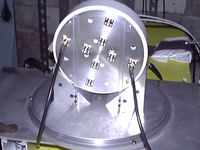Results with the active collimator in the Hall B photon beam
The Hall D active collimator prototype has been installed in the Hall B alcove. It is mounted on top of the total absorption counter (TAC) located just in front of the photon beam dump, as shown in the photos below. The photos were taken by Hall B Doug Tiles, who posted these and a number of other pictures of the setup on his web page. The inner sectors shown disconnected in the photos are actually connected during the tests.
The motion controls of the TAC are used to position the active collimator in or out of the beam. There are three positions of the TAC for these tests.
- Home: both the TAC and the active collimator are out of the beam. This is the default position for photon beam running in Hall B.
- Normalization: the TAC is in the beam and the active collimator is out of the beam. This is the position used for measuring the absolute tagging efficiency during special low-current (100pA) runs.
- HD-ACOL: the TAC is out of the beam and the Hall D active collimator is in the beam. This position enables GlueX collaborators to test the response of the active collimator during normal photon beam running with CLAS.
The height of the detector on top of the TAC has been adjusted so that when the central hole through the collimator is at beam height, the TAC is completely out of the beam. Additional lead shielding bricks have been stacked below the beam to prevent any exposure to the TAC when it is in the HD-ACOL position.
First Results
The Hall D active collimator was first inserted into the photon beam on April 4 around 6:30pm. The two inner sectors were connected to current-sensing preamplifiers and connected to a ADC and sampled at a rate of 1kHz. The electron beam current was 10 nA and the radiator was a 50 micron diamond. A current of 40 pA was observed one of the inner pin-cushion sectors, with a signal to noise ratio of 80:1. The electronic noise on the signal was on the level of 0.1 pA. The signal disappeared immediately during beam interruptions, so there was no doubt that it was caused by the beam. When the detector was out of the beam (HOME position) zero current was observed. The currents measured on the two opposing sectors of the active collimator were similar in magnitude but opposite in sign. One would expect the two currents to be positive, so this is probably a data acquisition bug. The Connecticut student who wrote the data acquisition software is investigating.
Initial simulations carried out by a student when the active collimator was being designed [1] indicated that a properly centered photon beam under nominal GlueX running conditions at 108 tagged γ/s should produce 200 pA in each of the inner sectors. The photon beam intensity in Hall B during the current test run at 10 nA corresponds to about 1% of the nominal GlueX operating intensity. If the Hall B beam spot on the collimator at 3.92 GeV were the same as the Hall D spot at 12 GeV then only 2 pA should be expected. The radiator-collimator distance in Hall B is approximately 50 m, as compared with 75 m for GlueX, so the test beam spot is a factor 2 larger than in the Hall D simulation. This could explain part of the excess signal observed. It is also likely that the Hall B beam is not exactly centered on the collimator at the current HD-ACOL position. If the beam is hitting one of the sectors directly then this would be expected to produce an order of magnitude increase in the current over the nominal alignment value. This can be checked by scanning the active collimator by stepping the TAC horizontal position controls to left and right of the HD-ACOL position. As soon as we understand the opposite-sign anomaly in the currents observed in the two sectors, we will request a scan to measure the beam position dependence of the detected currents. So far the results are very encouraging.
Radiation Dose
After about one day of being exposed to the photon beam, the active collimator was surveyed by the Radiation Control Group. No detectable excess radiation was found. The tests will continue under the assumption that exposure to the beam for the remainder of the tests will not activate the detector to a level that will exceed Jlab export restrictions.
Data Acquisition Issue Resolved
Under first results above it was mentioned that the polarity of the signals from the two channels seemed to be opposite. Igor checked the manual for the ADC card and discovered that a special setup program is needed to select between differential and single-ended mode on the ADC card. He found it was in differential mode, which would explain the opposite polarity between channels 0 and 1. Now it is in single-ended mode, and both channels exhibit the same response to the beam. The signal seen by the ADC has negative polarity. The preamplifier must be an inverter because the emission of knock-on electrons should result in a positive charge on the tungsten plates. The following results were obtained with beam current 9.2 nA, energy 4.756 GeV.
| -x sector | 4.50 ± 0.1 pA |
| +x sector | 92.0 ± 2.0 pA |
The stated uncertainties are dominated by the low-frequency noise (wandering) of the signal which is observed as a kind of random walk over the time scale of a couple of minutes. This seems to be associated with slow fluctuations in the beam position and current, because when the beam is off the detector current levels are remarkably stable.
References
1. "Simulation of a Position-Sensitive Tungsten Pin-Cushion Detector", C. Gauthier and R.T. Jones, gluex-doc-244 (2003).

